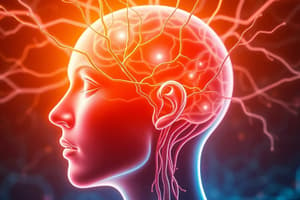Podcast
Questions and Answers
Which of the following best describes the concept of sensory adaptation?
Which of the following best describes the concept of sensory adaptation?
- Becoming more sensitive to a constant stimulus over time.
- Detecting a stimulus about 50% of the time.
- Becoming less sensitive to an unchanging stimulus. (correct)
- The conversion of sensory stimuli into electrical impulses.
According to Weber's Law, the difference threshold is a constant value, not a proportion.
According to Weber's Law, the difference threshold is a constant value, not a proportion.
False (B)
What is the term for learning which occurs through consequences of behavior?
What is the term for learning which occurs through consequences of behavior?
Operant Conditioning
The reappearance of a conditioned response after extinction has occurred is known as __________.
The reappearance of a conditioned response after extinction has occurred is known as __________.
Match the following Gestalt principles with their descriptions:
Match the following Gestalt principles with their descriptions:
Which of the following is the best example of negative reinforcement?
Which of the following is the best example of negative reinforcement?
Endorphins are synthetic substances that amplify pain signals in the body.
Endorphins are synthetic substances that amplify pain signals in the body.
What is the name of the process where sensory receptors convert stimuli into electrical impulses?
What is the name of the process where sensory receptors convert stimuli into electrical impulses?
__________ is the sense of balance, which involves the inner ear.
__________ is the sense of balance, which involves the inner ear.
Match the type of processing with the description
Match the type of processing with the description
Which concept explains why a dog might salivate to a sound similar to the original bell used in Pavlov's experiment?
Which concept explains why a dog might salivate to a sound similar to the original bell used in Pavlov's experiment?
Perception is primarily a physical process relying solely on sensory detection.
Perception is primarily a physical process relying solely on sensory detection.
According to the principles of behavior modification, what is the primary goal?
According to the principles of behavior modification, what is the primary goal?
__________ is the term for learning complex behaviors through operant conditioning by reinforcing successive approximations of the target behavior.
__________ is the term for learning complex behaviors through operant conditioning by reinforcing successive approximations of the target behavior.
Match the type of learning to its description:
Match the type of learning to its description:
In the Bobo doll experiment, what did Bandura aim to demonstrate?
In the Bobo doll experiment, what did Bandura aim to demonstrate?
Learned helplessness arises from exposure to controllable, escapable adverse conditions.
Learned helplessness arises from exposure to controllable, escapable adverse conditions.
What is the term for a chemical signal secreted by an animal that influences the behavior of other animals of the same species?
What is the term for a chemical signal secreted by an animal that influences the behavior of other animals of the same species?
The __________ theory combines physical and psychological aspects to explain pain perception.
The __________ theory combines physical and psychological aspects to explain pain perception.
Match the term with the definition.
Match the term with the definition.
Flashcards
Absolute Threshold
Absolute Threshold
The minimum stimulus intensity that can be detected about 50% of the time.
Signal Detection Theory
Signal Detection Theory
Theory explaining how we detect sensory stimuli amidst background noise; involves decision-making processes.
Difference Threshold (JND)
Difference Threshold (JND)
The smallest detectable difference in stimulus intensity; also known as the Just Noticeable Difference (JND).
Transduction
Transduction
Signup and view all the flashcards
Sensory Adaptation
Sensory Adaptation
Signup and view all the flashcards
Learning
Learning
Signup and view all the flashcards
Gestalt Principles
Gestalt Principles
Signup and view all the flashcards
Operant Conditioning
Operant Conditioning
Signup and view all the flashcards
Endorphins
Endorphins
Signup and view all the flashcards
Generalization
Generalization
Signup and view all the flashcards
Discrimination
Discrimination
Signup and view all the flashcards
Extinction
Extinction
Signup and view all the flashcards
Spontaneous Recovery
Spontaneous Recovery
Signup and view all the flashcards
Sensation
Sensation
Signup and view all the flashcards
Perception
Perception
Signup and view all the flashcards
Vestibular Sense
Vestibular Sense
Signup and view all the flashcards
Kinesthetic Sense
Kinesthetic Sense
Signup and view all the flashcards
Pheromones
Pheromones
Signup and view all the flashcards
Bottom-Up Processing
Bottom-Up Processing
Signup and view all the flashcards
Top-Down Processing
Top-Down Processing
Signup and view all the flashcards
Study Notes
- Absolute threshold is the minimum stimulus intensity detectable about 50% of the time.
- Signal detection theory involves becoming aware of a sensory stimulus and distinguishing it from background noise.
- Difference threshold is the smallest detectable increase or decrease in a stimulus.
- JND stands for just noticeable difference and is related to the difference threshold.
- Weber's Law states that the JND is proportional to the initial stimulus intensity.
- Transduction is the conversion of stimuli detected by specialized sensory receptors into electrical impulses.
- Sensory adaptation occurs when you become less sensitive to an unchanging stimulus.
- More stimulus is needed after sensory adaptation to achieve the same effect.
- Learning is a relatively permanent change in behavior, knowledge, capabilities, or attitudes.
- Learning is acquired through experience.
Gestalt Principles
- Similarity: Grouping similar items together.
- Closure: Perceiving incomplete objects as complete.
- Continuity: Seeing elements arranged on a line or curve as related.
- Figure/Ground: Distinguishing an object from its background.
- Proximity: Grouping nearby items together.
Reinforcement Types
-
Positive reinforcement: Adding something desirable to increase behavior.
-
Negative reinforcement: Removing something undesirable to increase behavior.
-
Primary reinforcement: Naturally reinforcing (e.g., food).
-
Secondary reinforcement: Learned reinforcer (e.g., money).
-
Continuous reinforcement: Reinforcing every response.
-
Partial reinforcement: Reinforcing some responses.
-
Endorphins are natural pain relievers.
-
Operant conditioning is learning through consequences.
-
Generalization is when stimuli similar to the original conditioned stimulus elicit a conditioned response.
-
Discrimination is when responses are only made to the original conditioned stimulus.
-
Extinction is the disappearance of a conditioned response over time.
-
Spontaneous recovery is the reappearance of a conditioned response after extinction (classical conditioning).
-
Sensation is the physical detection of stimuli.
-
Perception is the psychological interpretation of sensations.
-
The vestibular sense is the sense of balance.
-
The kinesthetic sense is the sense of body position and coordination, related to phantom limb sensations.
-
Pheromones are chemicals secreted externally in humans and animals, acting as signals for fertility or territoriality.
-
Bottom-up processing starts with individual parts to build a whole pattern, used in new situations.
-
Top-down processing immediately sees the whole pattern and breaks it down if needed, used in familiar situations.
-
Behavior modification applies learning principles to eliminate undesirable behaviors and encourage desirable ones.
-
The Bobo doll study, by Bandura, showed that children who observed aggressive models were more likely to act aggressively.
-
Shaping is teaching complex behaviors through operant conditioning.
-
Learned helplessness is passive resignation resulting from repeated exposure to inescapable and unavoidable adverse conditions.
-
Avoidance learning occurs when engaging in behavior to avoid negative consequences.
-
The number of pairings influences classical conditioning.
-
Immediacy influences operant conditioning.
Significance of Pain
- Pain causes withdrawal.
- Pain sets limits.
- Pain serves as a basis for learning.
- The gate control theory combines physical and psychological aspects of pain.
- Culture and social context impact how pain is expressed, felt, and treated.
Studying That Suits You
Use AI to generate personalized quizzes and flashcards to suit your learning preferences.




